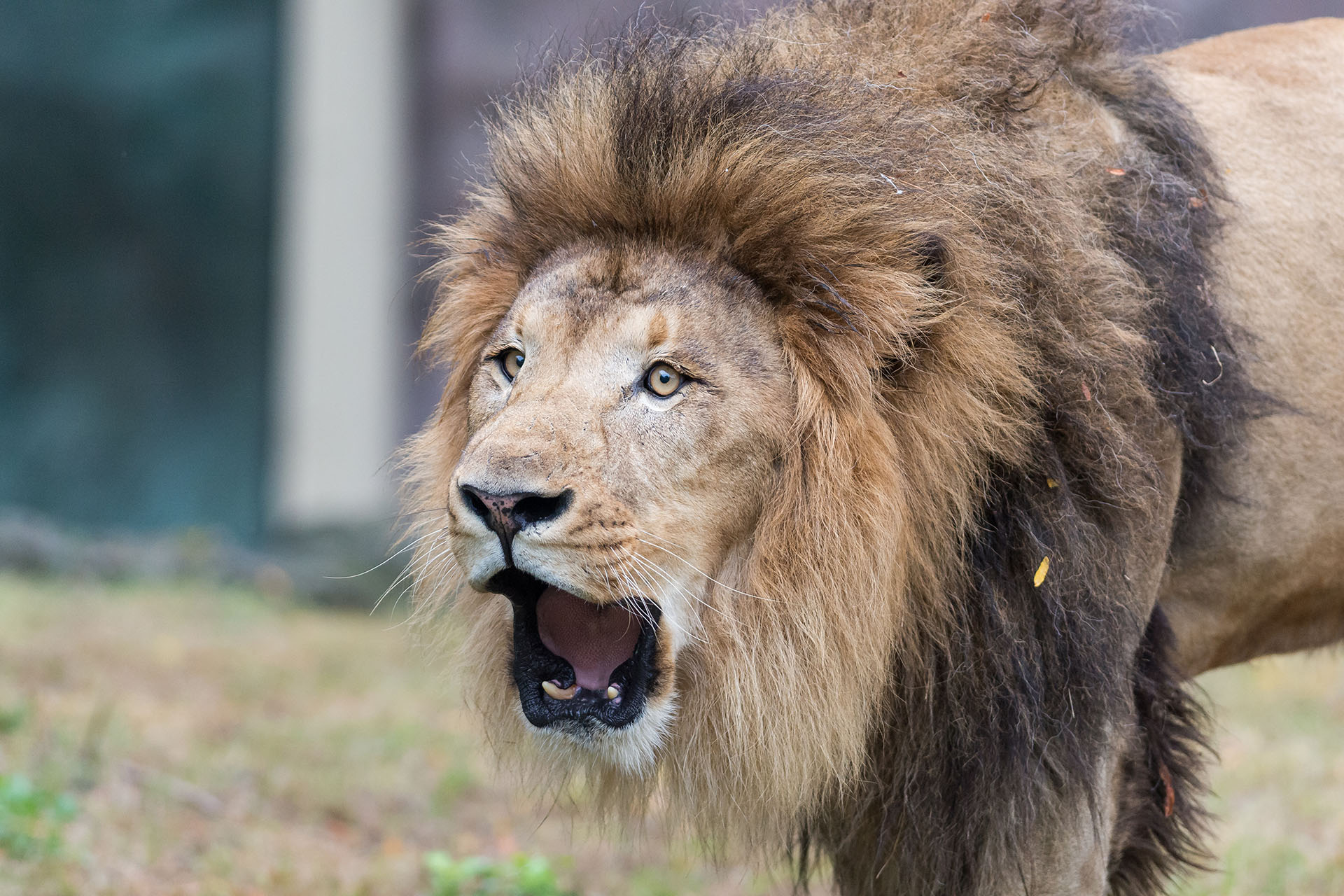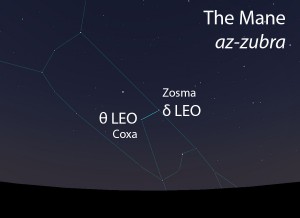Feature image by By Eric Kilby CC BY-SA 2.0, via Wikimedia Commons
As the weather warms up, and the rains with it, the stars of the great Arab megaconstellation of the Lion (al-asad) continue their westward march into the growing light of dawn. One of these stars, though also connected to the Lion, was more prominently known as the Weather Change (as-sarfa), which was nick-named the Dog Tooth of Time (nab ad-dahr). People typically show their canine teeth when they are smiling genuinely and broadly. The setting of the Weather Change was said to bring about such a smile on account of the growing herbage and flowers of spring. The spring rainy season (ad-dafa’i) was named for the warmth of its rains.
الصرفة ناب الدهر الذي يفتر عنه
The Weather Change is the Dog Tooth of Time,
which it shows smiling broadly.Arab saying
How to observe the Lion
When the whole Lion was above the horizon, it nearly covered the sky from west to east as it consumed some 135 angular degrees of the sky. In order to present this entire figure, the locator map below has a much larger scale than usual.
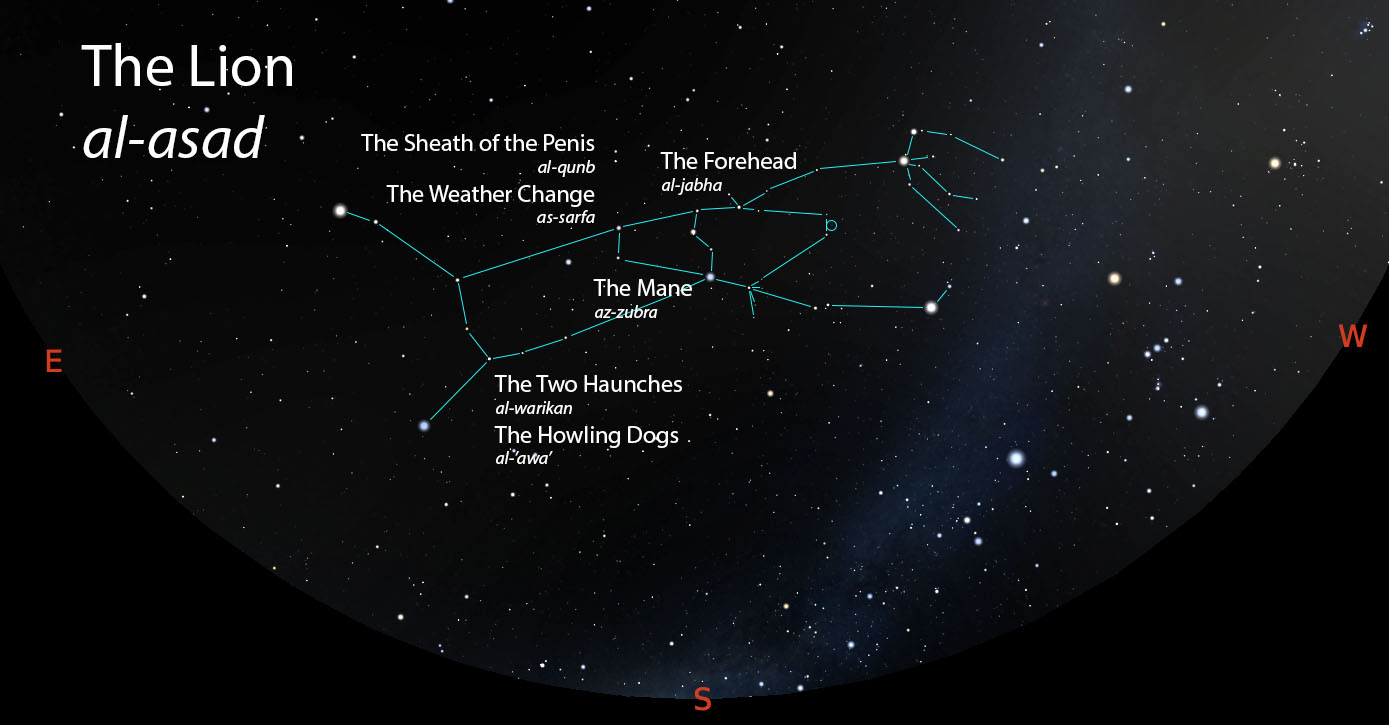
Wide-field view of the Lion (al-asad) and its elements as they appear when its Forehead (al-jabha) is in the middle of the sky. Sky simulations made with Stellarium.
The proper time to observe a star’s morning setting (or rising) is called ghalas in Arabic, at time when the darkness of night mixes with the white and red light of dawn in the tracts of the horizon (How to Observe). Look to the western horizon about 45 minutes before your local sunrise (times available at timeanddate.com).
The Forehead, the Howling Dogs and the Weather Change as rain stars
For a brief description of the rain stars, please see the Celestial Complexes section on the About page.
We saw last time that the setting of the first two stars of the Forehead of the Lion (jabhat al-asad) marked the end of winter (ash-shatawi). The setting of the second pair of stars of the Forehead heralded the beginning of the spring rainy season (ad-dafa’i). Although we now see these latter two stars set in the middle of March, from the latitude of Tucson and much of Arabia, this occurred in late February at the time that Qutrub wrote down his account of the rain star calendar of Qushayr. (This difference is a result of the precession of the equinoxes.)
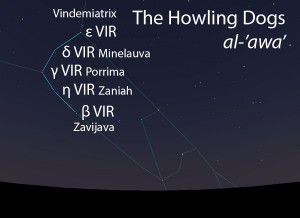
The Howling Dogs (al-‘awa’) as they appear in the west about 45 minutes before sunrise in early March.
Now, if you don’t happen to live in the desert, you might balk at the idea of the weather being anything close to “warm” in late February. After I came to Tucson, Arizona, from New Jersey many years ago, I remember spending my first January/February in the desert amazed at how quickly the desert heated back up to consistently warm temperatures. My winter had become much shorter than the one I had enjoyed in New Jersey.
About two weeks after the Forehead’s last star has set, the next asterism of the spring rains begins to set. The Howling Dogs (al-‘awa’) is a grouping of either four or five stars that was said to resemble either the Arabic letter kaf in its medial form (ىكى) or the Arabic letter alif in its final form (ىا). For English readers, it could be said to look like a tilted capital L, or perhaps a less-than sign (<). The whole asterism takes 25-30 days to set, depending whether you count four or five Howling Dogs. Regardless of the number of its dogs, this asterism gets its name from the coldness of the weather when it rises just before sunrise, which causes dogs to howl in discomfort. It was also said that this star grouping marked the Haunches (warikan) of the Lion.
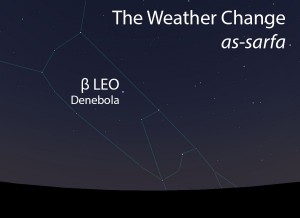
The Weather Change (as-sarfa) as it appears in the west about 45 minutes before sunrise in early March.
The last rain star of the spring rainy season was regarded by some to represent the Sheath of the Penis of the Lion (qunb al-asad), on account of its location slightly between and ahead of the Haunches (warikan). However, this solitary bright star was far more widely known as the Weather Change (as-sarfa), and this is how Qutrub identified it in the calendar of Qushayr. Its name comes from the verb sarafa, which means “to turn back from its way” or “to shift from one condition to another.” It was so named because at its setting before dawn in late March (or mid-April for us today) the cold turned away and changed to warmth. Likewise, its dawn rising just ahead of the sun signaled the turning away of the heat and the transition to cold weather.
إذا فطم الصبي بنوء الصرفة لم يكد يطلب اللبن
When the child is weaned
by the rain star of the Weather Change,
he scarcely asks for milk.Arab saying
Looking at the star map, you might be inclined to argue that Qutrub must have been wrong in his presentation of the order of the rain stars of spring (ad-dafa’i), which places the Howling Dogs in the middle and the Weather Change at the end. The Weather Change lies further to the west than any of the stars of the Howling Dogs do, so it should set before them, right? Depending whether you count four or five Howling Dogs, its first star actually sets either ten or four days before the Weather Change does. This happens because the Howling Dogs have a lower elevation in the sky than the Weather Change does, so their stars begin to set first.
The Weather Change is the last rain star of the spring rains, but the Lion has one more rain star asterism to give us, which we will see in the next post.
The Forehead, Mane and following as lunar stations
For a brief description of the lunar stations, please see the Celestial Complexes section on the About page.
The Forehead, the Howling Dogs and the Weather Change were each included in the calendar of the lunar stations, but their order was different than their order in the rain star calendar of Qushayr. The Forehead was the 10th lunar station, following the Eyes, as we saw in the last post. As for the Howling Dogs, even though they began to set before the Weather Change did, their location further east along the moon’s path made them the 13th lunar station, following the Weather Change, the 12th lunar station.
The calendar of lunar stations typically filled in the gaps between existing rain star asterisms, as long as those rain star asterisms were near the path of the Moon through the night sky. The 11th lunar station fills in the large gap between the Forehead (10th) and the Weather Change (12th) with a pair of bright stars that also belong to the Lion (al-asad). This 11th lunar station was the Mane (az-zubra) of the Lion. Outside of the context of the lunar stations, this pair of stars was also called the Two Ribs (al-kharatan). The two bright stars of the Mane follow in the tracks of the Forehead but lie closer to the Weather Change.
The final lunar station that has ties to the Lion will come in the next post, when we look at the season of summer (as-sayf).
Roars of the Mesopotamian-Greek Lion
Returning again to the smaller image of the lion among the Greeks and the Mesopotamians before them, later Arab descriptions of this foreign image survive to this day as standardized star names. The bright star that the Arabs called the Weather Change, or the Sheath of the Penis of the Lion, was in this smaller depiction of the Lion its tail. Today, this star is called Denebola (β LEO), from the Arabic dhanab al-asad, “the Tail of the Lion.” The Weather Change (as-sarfa) has been lost in the modern sky.
The neighboring Greek constellation of Virgo, the Virgin, houses the four or five stars that among the Arabs once constituted the asterism of the Howling Dogs. I commented above that the shape of the Howling Dogs resembled a medial Arabic letter kaf or an English capital L. At some point, the middle star of this grouping, today called Porrima (γ VIR), was called zawiyat al-‘awa’, the Angle of the Howling Dogs. This name became corrupted under Latin transliteration and was much later applied in different forms to two other stars of this grouping as Zavijava (β VIR) and Zaniah (η VIR).
What’s next?
In the next post, we conclude our extended journey through the stars of the Lion with a renowned pair of stars that by themselves defined the period of the summer rains.
In the meantime, I’d love to hear from you! Please leave a comment below, and tell me about your observations of these ancient asterisms. Be sure to include your city and state/country so we can see how the timings vary by location.
Star Catalog Entries for this Celestial Complex
The Lion Celestial Complex (al-asad, الأسد)
The Forehead (al-jabha, الجبهة)
The Mane (az-zubra, الزبرة)
The Weather Change (as-sarfa, الصرفة)
The Sheath of the Penis of the Lion (qunb al-asad, قنب الأسد)
The Howling Dogs (al-‘awa’, العواء)
The Two Haunches (al-warikan, الوركان)
Click here to go to the full star catalog (a work in progress).

